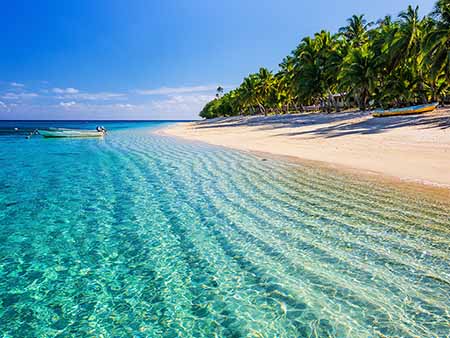
The complete guide to food in Fiji
Traditional cuisine and modern favourites
330 tropical islands fringed by kaleidoscopic reefs under translucent water; it’s easy to see why Fiji is better known for its coastline than its cuisine. However, Fijian fare has so much more to offer than the resort buffet reveals.
As a nation bordered by water, it’s no surprise that seafood makes up a large part of Fiji’s culinary world. But modern-day Fiji is a diverse society with prominent Asian influences, where you may just find the best curry of your life.
In this article, we dive into all that Fiji has to offer to food lovers, from traditional delicacies to modern street food favourites.

Traditional food in Fiji
What do Fijians typically eat?
Like its neighbours in the South Pacific, Fijian food has traditionally centred around a few staple ingredients that are readily available on the archipelago. So what do Fijians eat? Rice, sweet potatoes, taro (a tropical root vegetable), coconuts, cassava (a starchy shrub), breadfruit, and of course, fish, have made up the majority of the Fijian diet for centuries.
Traditional Fijian dishes
Lovo: Lovo is Fiji’s answer to the barbecue. The traditional feast of fish, meats and vegetables wrapped in banana leaves is cooked in a makeshift underground oven that is dug into the earth, lined with coconut husks and covered with stones. Lovo meals are traditionally prepared to celebrate significant events in the village, like a wedding or a festival. Today, most resorts offer regular lovo feasts for their guests to enjoy.
Kokoda: Just like the Peruvians have ceviche, the Fijians have kokoda - a delicacy made of raw fish marinated in coconut cream, onions, tomatoes and lime. Kokoda is now a staple in any resort restaurant with access to fresh mahi mahi fish (also known as dorado or dolphin fish). Just like if you were eating sushi or sashimi, travellers should make sure that the fish used in kokoda is freshly caught and prepared hygienically. Some unlucky travellers to Fiji have suffered intense food poisoning requiring hospitalisation due to resort food.
Kava: Like many other traditional dishes in Fiji, Kava drinking is a ceremonial activity. Kava is made from the root of yaqona (related to the pepper plant), which is ground and strained with water into a large wooden bowl. Kava ceremonies are celebrated to bring two groups of people together, which is why visits to local villages often begin with a kava offering. The drink is famous for its numbing effect. We’ll cover more on kava drinking etiquette and safety further along in this article.

Indian and Chinese food in Fiji
Arriving to Fiji, you may be surprised by the fragrant and familiar scent of curries, naan bread and roti wafting on the tropical breeze. Roughly 40% of Fiji’s population is of Indian descent, with the cities of Nadi and Suva brimming with temples, shrines and tasty Indian eateries. In the late 19th century and early 20th century, Indians were sent to Fiji by their British colonial rulers to work on sugarcane plantations.
Indo-Fijian food is like anything you’d find in Delhi or Mumbai, with spicy curries, rice and roti bread. Suva and Nadi are the epicentre of the Indian population in the country, and as such, they boast countless options for food lovers with a taste for spice. Just note that many of the Indian restaurants in Fiji do not serve alcohol.
Fiji also has a small but influential population of Chinese, which is evident with a number of popular Chinese restaurants in city centres.

Street food in Fiji
The street food scene in Fiji is far from the famous bustling markets of Thailand or Malaysia. The ‘Street Foods Fiji’ project outside Denarau is as close as the country comes to authentic micro restaurants, selling a variety of traditional and Indo-Fijian snack plates.
Nadi Market is a fairly relaxed scene where local produce is sold without fuss and very little haggling. Fish, taro, bananas, pineapples, sugarcane and kava are in plentiful supply, although you’d be lucky to find any local sellers preparing cooked food at the market. If you’re buying food at the Nadi Market to prepare yourself, steer clear of peeled fruit and fish - the market does not have a freezer section so freshness is not always guaranteed for meat products.

Resort food in Fiji
Resort food often has a reputation as poor quality, unhealthy and unhygienic. Food poisoning has been an unfortunate theme in Fiji, with a number of travellers reporting violent sickness after eating contaminated food at their resort. Buffets can be open-air, making food vulnerable to contamination by other guests or by standing for a long time following cooking. When eating food from the resort buffet, remember to:
- Only eat fresh and well-cooked food.
- Avoid hot meals that have gone cold, and cold meals that have gone warm.
- If you’re concerned about the resort’s hygiene, avoid eating shellfish.
- Make sure you use serving utensils that are kept clean and dry. If none are available, don’t be afraid to ask the resort staff.
- Request that your drink doesn’t include ice cubes, as they can be contaminated with poor water or during handling.
Despite some unfortunate cases of sick travellers, most of the resorts in Fiji strive to deliver great quality food to their guests.

Fiji food prices
Food prices in Fiji are typically lower than what you’d expect in New Zealand, with affordable fruits and vegetables available from the markets and many well-stocked supermarkets in Nadi. If you’re planning on some home cooking, the Lautoka Market north of Nadi is well-renowned for its plentiful supply of cheap local seafood.
But if you’re like most travellers to Fiji, chances are you’ll be enjoying the majority of your meals at local restaurants or within your resort. Meal prices can vary widely between resorts in Fiji depending on the budgets they cater to, however many resorts have a selection of on-ground restaurants to suit your budget. For a mid-tier family resort like Plantation Island on Malolo Lailai, you can expect to pay between $15 - $20 for main courses.
Note that many menus will display a price in Fijian dollars alongside Australian dollars, so it’s helpful to have a currency conversion app on your phone to keep track of what you’re spending in NZD.
What is Kava in Fiji?
If you’re exploring traditional Fijian fare while on holiday, chances are you’ll encounter Kava - Fiji’s traditional drink famous for its mild sedative quality and use within traditional ceremonies. Kava is made from the root of the yaqona plant, which is crushed and then strained with water.
After drinking kava, people report feeling calm and relaxed, alongside a slight numbing of the lips, tongue and mouth.
Kava Ceremony etiquette and safety
A traditional kava ceremony can be one of the most memorable experiences on your trip to Fiji, however there are some etiquette and safety considerations to remember. Kava ceremonies traditionally mark a coming together of two groups, and is often offered to guests who visit Fijian villages. Likewise, it is often expected that guests bring a gift of kava root to villages, which can be bought from local markets.
Kava ceremonies are ancient traditions that follow a strict structure and etiquette. If you’re joining a kava ceremony, remember:
- Everyone is expected to remain seated during the ceremony.
- Men and women should dress modestly, with women usually wearing a sarong.
- The eldest man in the group enters the ceremony first, followed by the rest of the men and the women.
- The eldest man in your group is considered the chief and is expected to present your kava offering and to drink first.
- Men drink first followed by women.
Ceremonies are followed by singing and dancing as the two groups are joined, and visitors are now free to explore the village.
Kava safety is a common concern for visitors to Fiji. There have been recent reports that products labelled as kava have been linked to acute liver damage, which can cause serious illness and even death. The general consensus is that kava is safe for adults in moderate amounts.

Eating in Fijian villages
Some villagers may also offer for you to join in their lovo feast, and while you should oblige, it’s important that you pay close attention to the quality of the food being served before you eat it. One New Zealand woman contracted a rare disease, ciguatera poisoning, after ingesting a coral trout prepared for her by local villagers. She immediately noticed the bitter flavour of the fish and some of its gut on the meat, and then suffered from severe vomiting and diarrhoea, which lasted over a year after returning from Fiji.
It’s easy to spend your Fijian holiday sticking to the western meals offered by many of the country’s resort restaurants. In some cases, these may be the safe choice, but exploring traditional and modern Fijian food can be a surprising and enjoyable culinary experience.
The content of this article is general and provided for information purposes only. Southern Cross Travel Insurance (SCTI) doesn’t guarantee or warrant the accuracy, completeness or currency of any article.
This article may contain hyperlinks to other websites owned or operated by third parties, or references to third party products or services. SCTI isn’t responsible for, and makes no recommendation about, the content or accuracy of any third party website, or for the suitability or performance of any product or service. The inclusion of a link in this article doesn’t imply that SCTI endorses the website or third party product/service.





